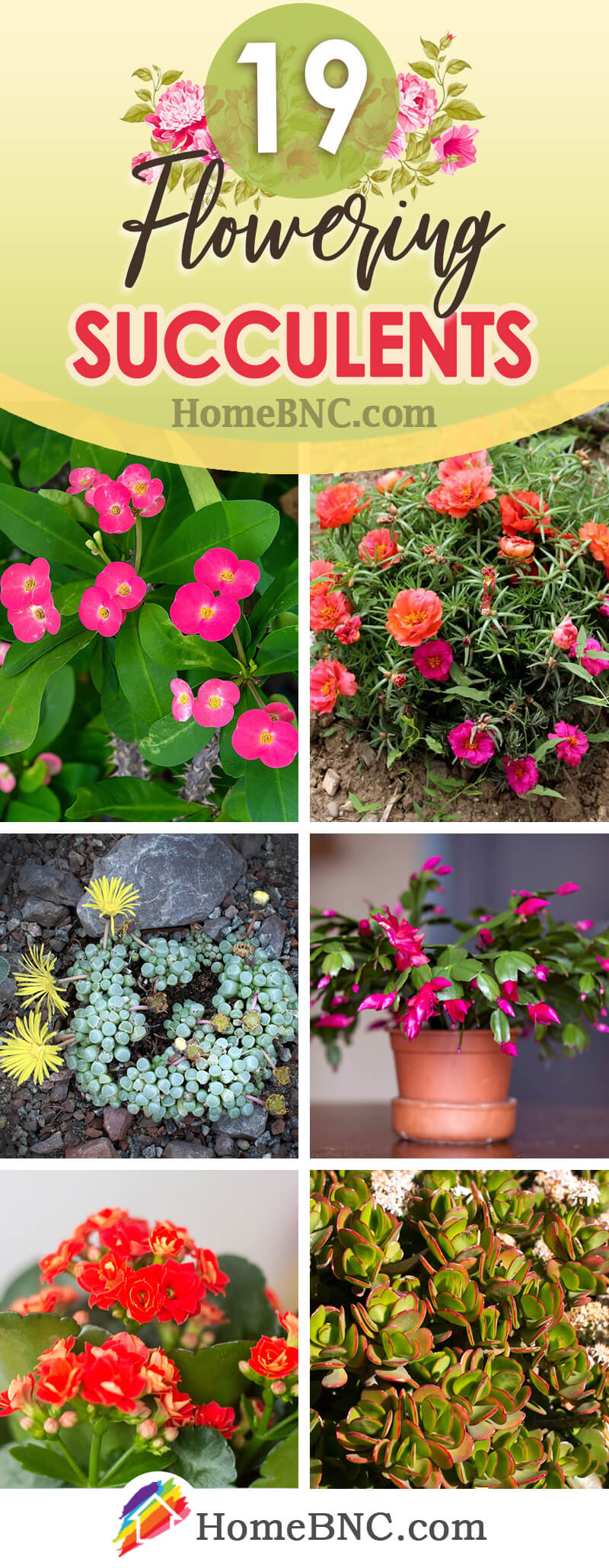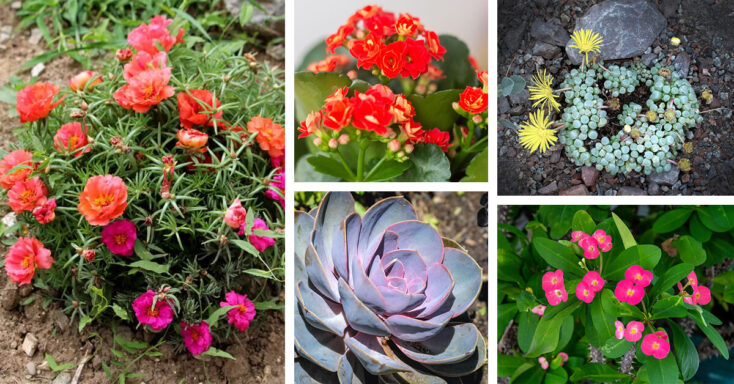It is impossible to deny that succulents offer some of the most interesting foliage in the entire world of gardening. Those fleshy leaves come in a wide range of fantastic shapes and colors, but they serve a functional role as well. By storing large quantities of water, the leaves of a succulent allow the plant to survive in dry conditions, which is what makes them the perfect low-maintenance plant option for indoor gardeners. However, what many people overlook is the fact that along with that amazing foliage, succulents can provide beautiful flowers as well, as this list will prove by introducing you to the top 19 low-maintenance flowering succulents.
Key Takeaways
Succulents are some of the most interesting plants you can grow, and learning about each one will provide you with a lot of useful information. But with that said, there are also a few broader points about succulents that you should understand. Below are five key takeaways about succulents that you’ll notice throughout this list of flowering succulent plants:
- Succulents are the perfect plant group for indoor gardeners.
- Most succulents will thrive without much maintenance.
- There is a surprising amount of succulents that bloom with astounding flowers.
- Some succulents are only able to bloom when growing outdoors or at the end of their life.
- The succulent family is very diverse, as it includes not only many species but many genera as well.
19 Stand-Out Low-Maintenance Flowering Succulents that Grow with Ease
1. Aloe vera (Aloe vera)

We’ll kick off our list with one of the most famous succulent plants both inside and outside the gardening world. Aloe vera is equally popular among those who want to grow it as an ornamental plant as it is among those interested in the plant’s health benefits. The aloe vera plant’s most prominent feature is its foliage, which is long, slightly triangular, and full of an oozing liquid substance that is the source of this plant’s holistic benefits. For most of this plant’s life, that foliage is all that’s present above the soil. But when aloe vera reaches the end of its lifespan, it will develop a large spiky flower that has a pinkish-orange color.
2. Baby Toes (Fenestraria rhopalophylla)
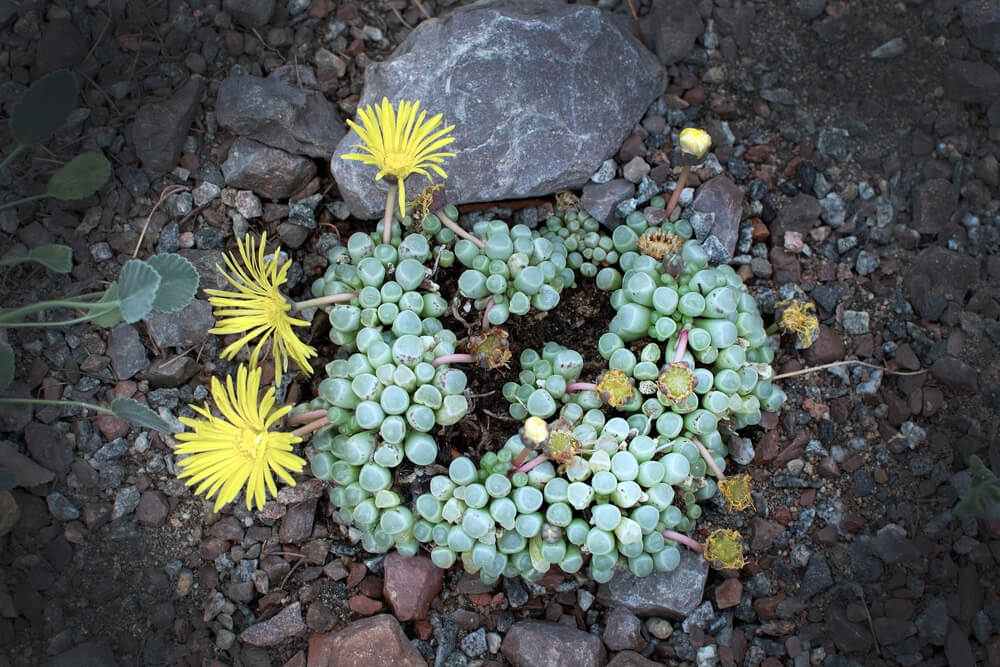
Although it sounds a bit strange, the common name baby toes is an apt way to describe the physical appearance of the Fenestraria rhopalophylla succulent plant. Baby toes grow via fleshy vertical foliage that has an almost cylindrical shape. That form and size make the plant look remarkably like a set of baby’s toes. As if that interesting foliage was not enough, the baby toes plant also blooms with large daisy-like flowers. Those flowers are typically white with yellow centers or entirely yellow. Fortunately, baby toes are also as easy to care for as they are visually interesting. As long as you give this plant full sun, it will survive just fine.
3. Christmas Cactus (Schlumbergera bridgesii)

Christmas cactus, so called because it blooms in and around the holiday season, is a low-maintenance flowering succulent that has a beautiful growth habit. This plant has foliage that is fleshy and almost chain-like in its habit. That long foliage will arch in every direction and weep over the side of whatever container it grows in. During the bloom time, you’ll see the flowers for which this plant is so prized open at the end of the foliage, showing off shades of pink, white, and purple. That convenient color display makes Christmas cactus the perfect festive plant for the later parts of the year.
4. Crown of Thorns (Euphorbia milii)

There are a few features that make the crown of thorns plant stand out from other succulents on this list. The first example of that is this plant’s leaves, which are thinner and less fleshy than those of other succulents. Crown of thorns also stands out due to its thick stems, which are incredibly spiky, and inspire the common name. However, while those stems don’t appear so inviting, the flowers certainly do. Those small blooms form in clusters and typically have a pink hue and a pleasant round shape.
5. Desert Rose (Adenium obesum)
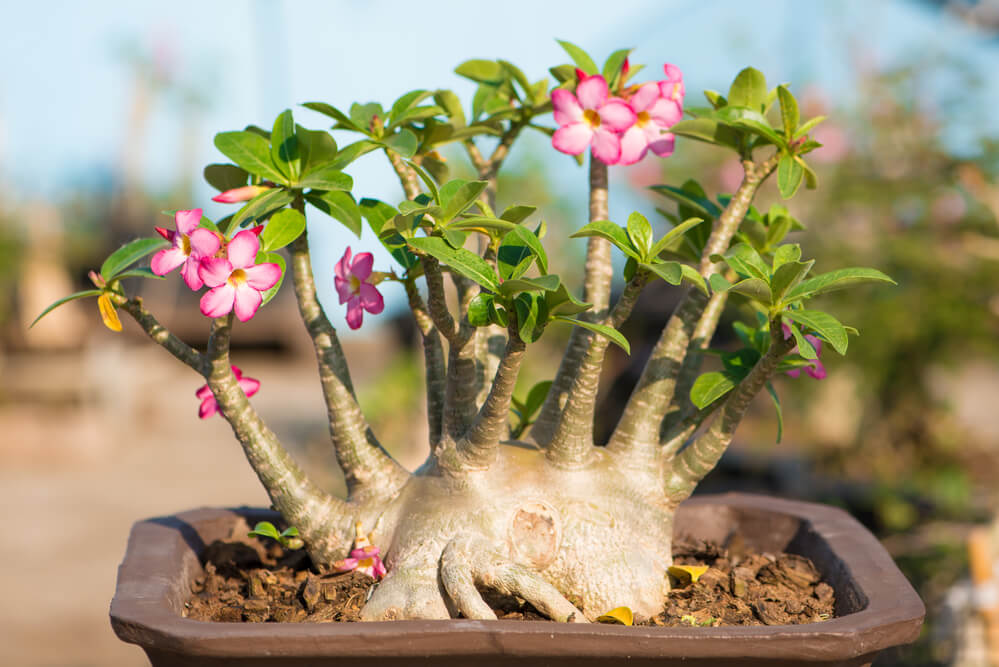
With a name like desert rose, you would expect this succulent species to have some great bloom characteristics, and if you made that assumption, then you are one hundred percent correct. The desert rose is a succulent species with large, rose-like flowers. The petals of those flowers can be entirely pink but may also show varying intense shades of magenta and white. Desert rose also has an interesting growth habit, even compared to the other plants on this list. This species forms woody branches that emerge from a squat irregular trunk. Desert rose can also get quite large, but that typically occurs only when this plant grows outdoors in its native region or a location with similar growing conditions.
6. Echeveria (Echeveria)

Of all succulent plants, the Echeveria plant may be the most recognizable. Since this plant is so easy to grow in containers, it is one of the most commonly grown succulents in homes throughout the world. Echeveria plants have thick round leaves that grow in a radial pattern. They also have a green-blue color that can show hints of magenta as well. The Echeveria plant will bloom only once in its lifespan. However, some people say that the pattern and shape of the foliage look a lot like a flower as well. Fortunately, you’ll be able to enjoy that foliage no matter the season throughout this plant’s entire life.
7. Flaming Katy (Kalanchoe blossfeldiana)
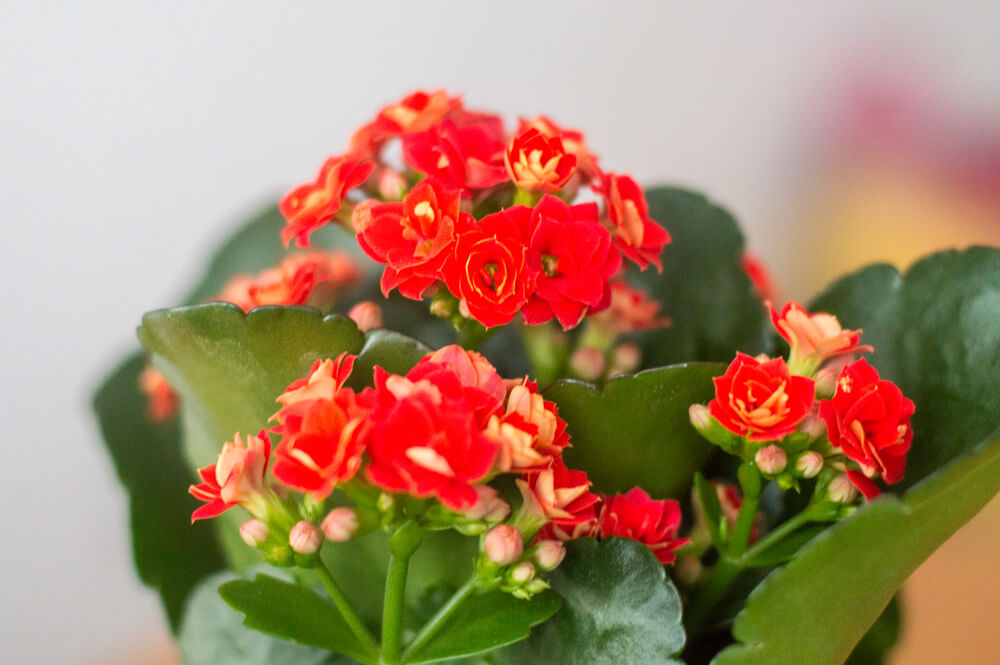
While some succulents are so rare that their name is unfamiliar to most, here is one of the succulents that is common enough that the average gardener may at least recognize it, if not know it by name. Flaming Katy is among the best blooming succulent plants around. Unlike other flowering succulent varieties, Flaming Katy does not bloom once at the end of its life. Instead, this succulent blooms repeatedly throughout its life. Those flowers are on the smaller side, and they form colorful clusters as they open. Typically, the flowers of the Flaming Katy plant will be some shade of red, orange, or yellow, which makes it no surprise where this plant gets its common name.
8. Ghost Plant (Graptopetalum paraguayense)
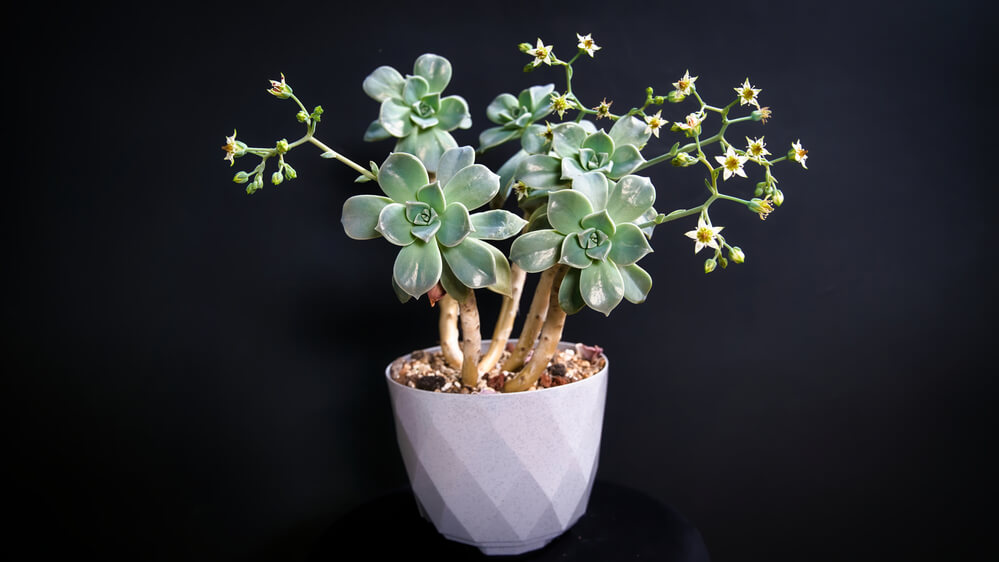
Although the name of this plant sounds quite scary, there is very little chance that you’ll feel afraid when caring for it. On the contrary, since Ghost plants are so easy to care for, you won’t need to worry about much at all. This plant has foliage that is a lot like that of the Echeveria plant. However, the Ghost plant has a much different growth habit than an Echeveria. It has light tan stalks on which the foliage grows. This plant also develops irregular stems that emerge from the plant at random angles and hold the flowers, which are small, off-white, and star-shaped.
9. Ice Plant (Aizoaceae)

At first glance, you may notice that the flowers of an ice plant look a lot like the famous blooms of an aster plant. However, while the resemblance in flower characteristics between these species is a reality, the two plants are not related at all. Still, both are more than worthy of earning a place in your garden. In the case of the ice plant, you’ll find that the long purple petals of this plant have an incredibly shiny surface that allows them to interact beautifully with natural light. This plant also has interesting foliage that is shaped almost like a bean pod.
10. Jade Plant (Crassula ovata)
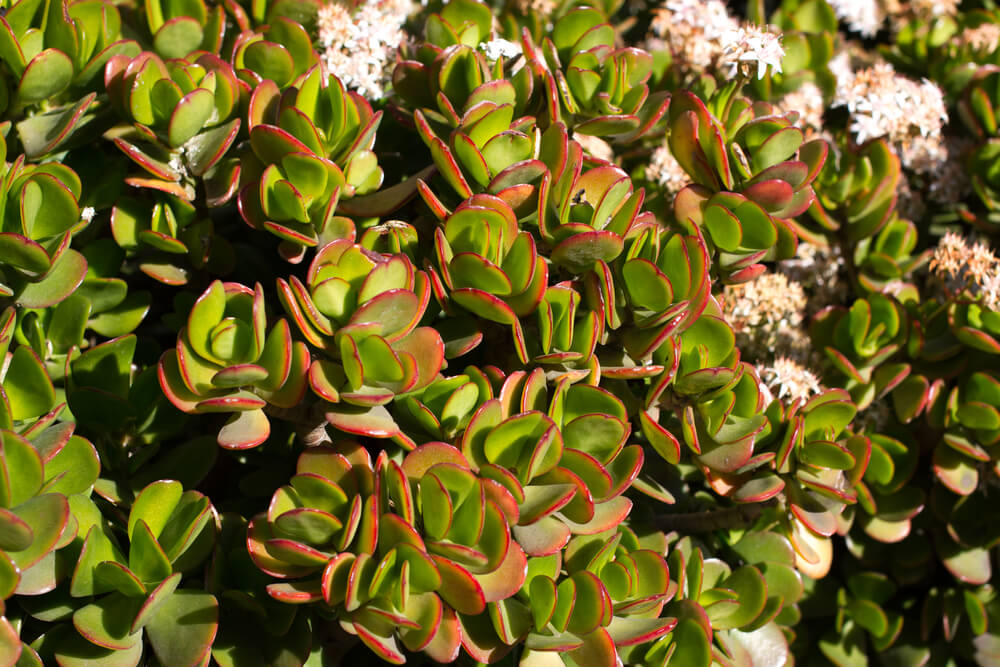
The jade plant sometimes goes by the name money plant due to the belief that this plant can bring you good luck and prosperity. But whether you believe that about jade plants or not has nothing to do with whether you should grow this low-maintenance flowering succulent in your home. Jade plants have beautiful round leaves that are quite lustrous. Additionally, although uncommon, it is also possible for a jade plant to bloom with small white or pink flowers. But since this is rare, most gardeners who grow jade plants will have to appreciate them for other reasons.
11. Lifesaver Plant (Huernia zebrina)
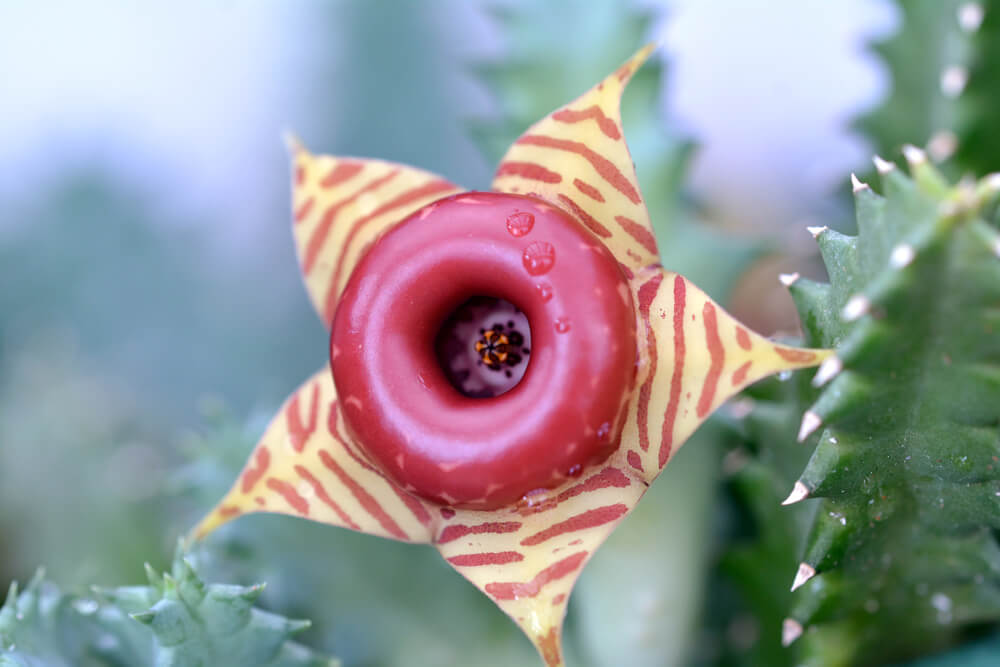
The lifesaver plant is not only a low-maintenance flowering succulent, but it is also a plant that has some of the most mesmerizing flowers in the world. In fact, these flowers are so other-worldly that you may have a difficult time believing they are real at all. Each bloom has a large center portion that is deep red and shaped like a small donut. Around that center portion are five petal-like structures that have a zebra-like pattern of light yellow and red streaks. Of course, the best way to truly understand what this flower looks like is to raise one yourself.
12. Moss-Rose Purslane (Portulaca grandiflora)
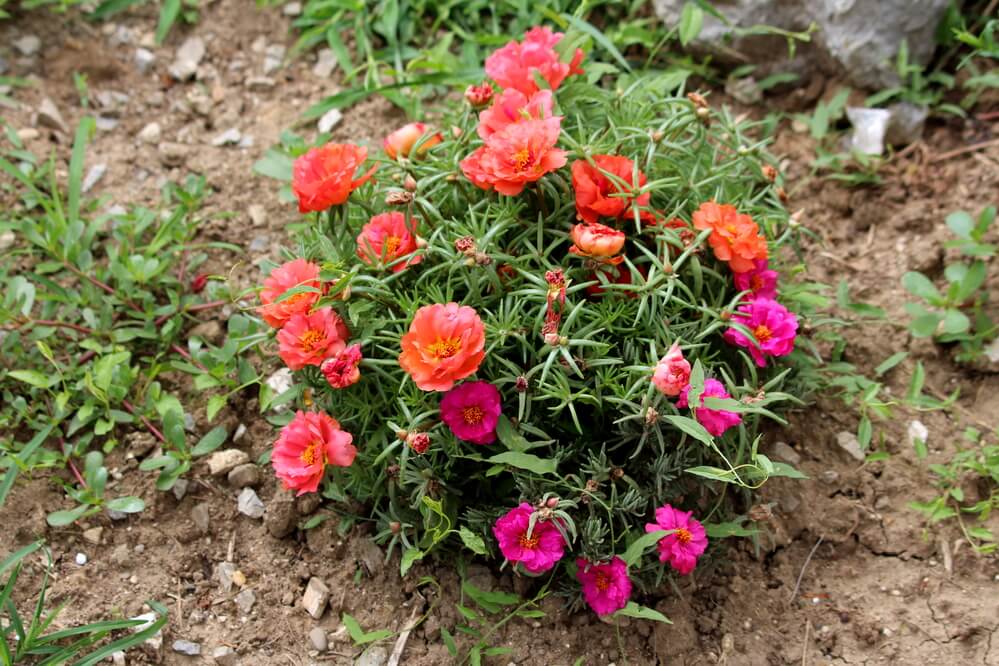
This next low-maintenance flowering succulent is a perfect contrast to the previous one on the list. While the lifesaver plant had a fantastical flower shape and color pattern, the flowers of the moss-rose purslane are, for lack of a better word, a bit more ordinary in their form. These flowers have a simple yellow center and five petals that surround them. But what makes those flowers quite interesting is that they can appear in different colors, including yellow, purple, red, and white, even while growing on the same plant.
13. Queen of the Night (Epiphyllum oxypetalum)
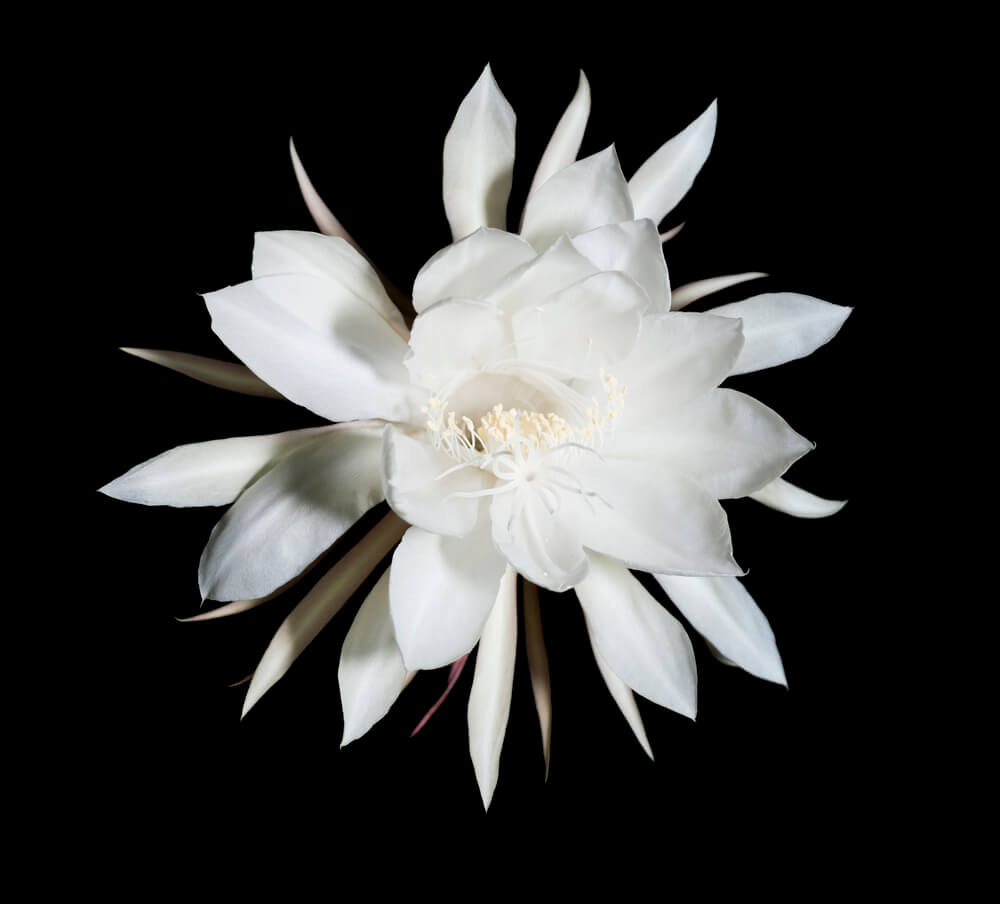
There have been plenty of flowers on this list that we could describe as interesting, but this one may be the most interesting of all. However, that level of interest is not only a result of the appearance of this flower but the manner in which it blooms as well. Interestingly, the flower of a queen of the night succulent opens only during the nighttime hours. During those darker parts of the day, you can enjoy the incredible shape and stark white color of those blooms as long as you give this plant indirect light during the day.
14. Old Lady Cactus (Mammillaria hahniana)
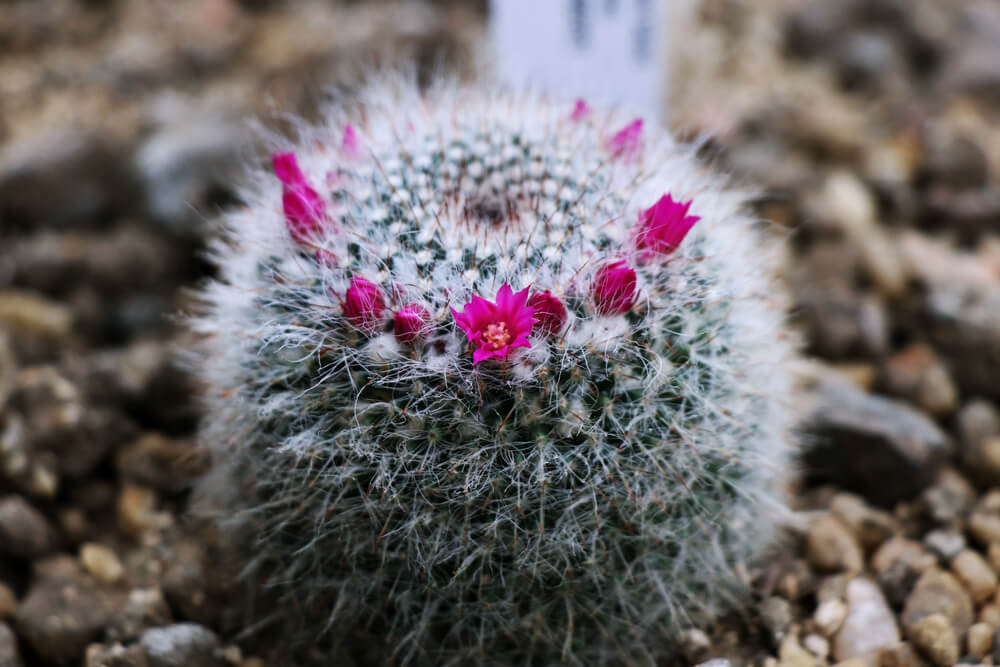
Old lady cactus may not sound like a flattering name, but this plant is sure to flatter you and your indoor garden guests if you choose to plant it. The old lady cactus is small and round with many white feathery appendages that give the plant a fantastic texture. Old lady cactuses also have great flowers that provide an excellent contrast to the rest of the plant. Those flowers emerge at the very top of the plant, and they have a vibrant magenta color.
15. Orchid Cactus (Disocactus ackermannii)
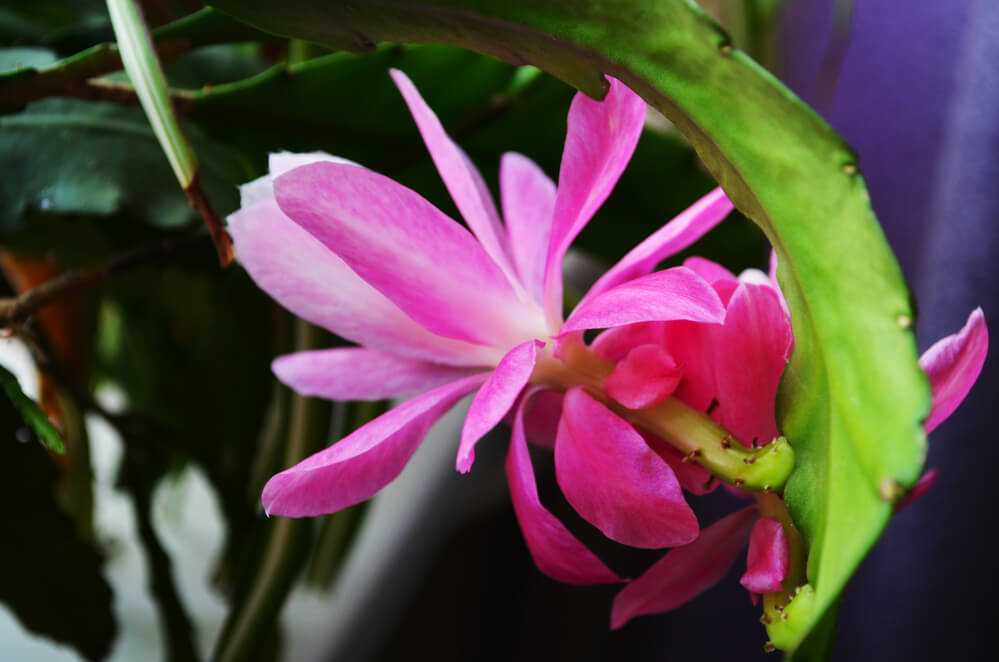
If you are a fan of succulents that have larger flowers, then the orchid cactus is the right plant for you. Orchid cactus blooms can be more than half a foot across in some cases. Those large petals make a fantastic color display as well. In most cases, they will show varying shades of light pink. However, it is also possible to find other colors for this plant, including yellow, orange, and white. With some basic maintenance, including providing indirect light and a moderate amount of fertilizer, your orchid cactus will look amazing.
16. Paddle Plant (Kalanchoe luciae)
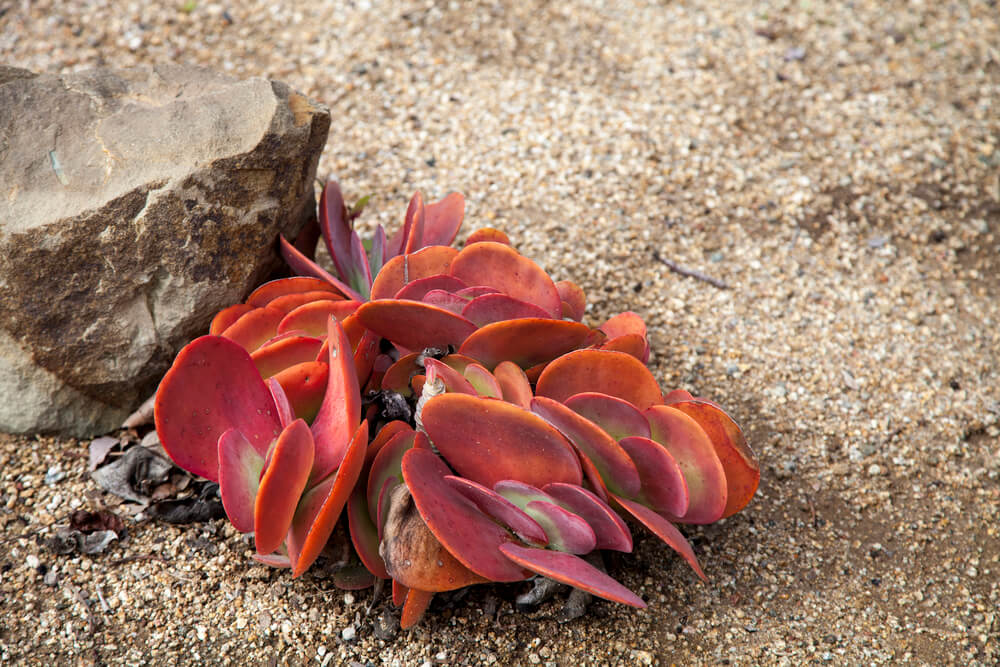
The paddle plant gets its name from the shape of its leaves, which are a few inches long with an oval shape. The leaves surround a single central stem, and since the leaves at the bottom are generally larger than the ones at the middle and top of the plant, the paddle plant tends to have a pyramidal shape overall. At times, in the center of that pyramidal shape, the paddle plant will add to its beauty with a cluster of small reddish-orange flowers.
17. Peanut Cactus (Echinopsis chamaecereus)
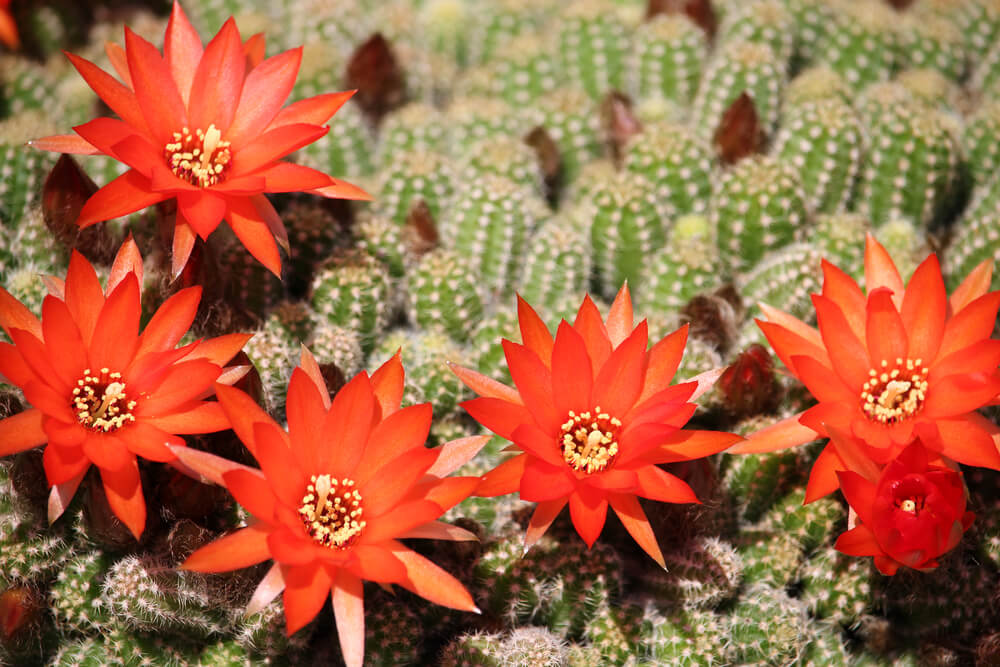
The peanut cactus is rare in that it can provide multiple types of visual interest at once. For example, the foliage of this plant is small and round, with a distinct cuteness. By contrast, the flowers of this plant are incredibly dignified and elegant in their appearance. They have oblong petals with a fiery red shade that surround a bright yellow center. Plant this species in soil that is both loose and acidic, and you can expect it to grow healthily to a size of a few inches tall.
18. Pin Cushion Cactus (Mammillaria crinita)
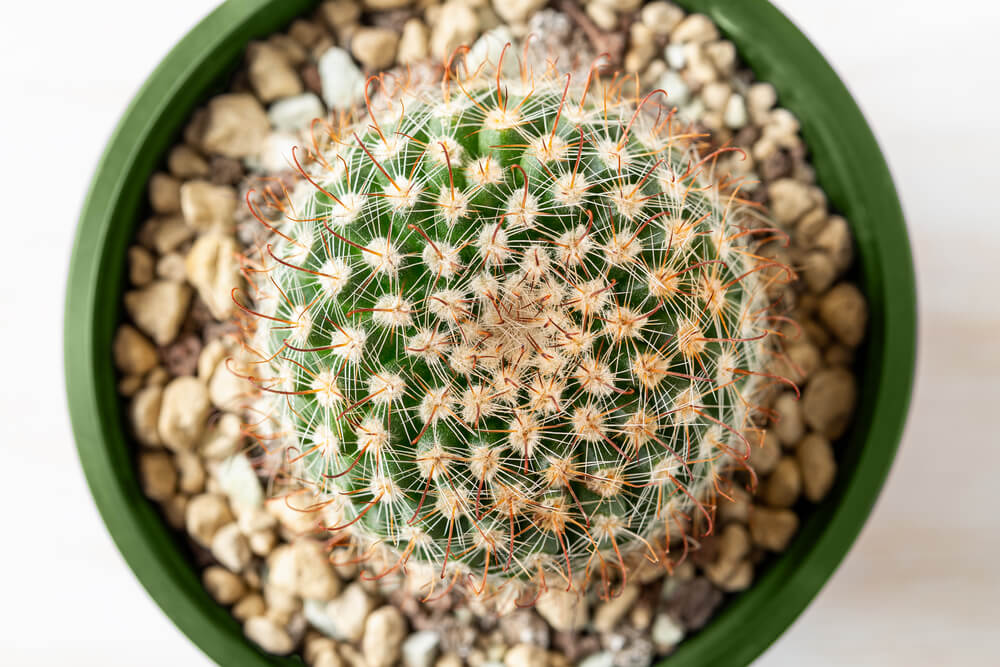
It’s true that succulent plants can come from a wide range of genera, but this entry on our list is related to another one we have already mentioned. Both the pincushion cactus and the old lady cactus come from the same genus and have a similar round shape with a feathery texture. The flowers of both these low-maintenance flowering succulents are also quite similar. On the pincushion cactus, the flowers are bright purple and encircle the top of the plant like a crown.
19. Ruby Ball Cactus (Gymnocalycium mihanovichii)
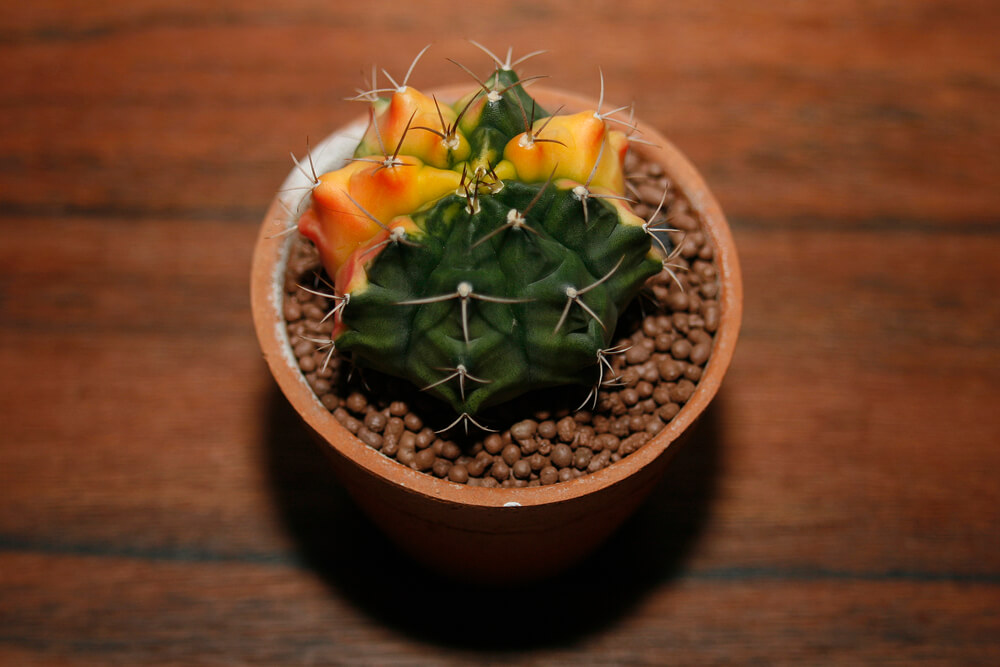
The last entry on our list of the best low-maintenance flowering succulents may be one of the most visually impactful. This cactus plant has a single main stem that’s green and rigid, atop which sits a colorful round structure that can present varying shades, including red, yellow, and a dark purple shade that is nearly black. That unique appearance has led this plant to adopt several descriptive common names, including ruby ball cactus and moon cactus. Of course, as is true of the other plants on this list, the ruby ball cactus is also incredibly easy to care for. In some cases, it can even survive in some particularly shady conditions, which is not always true of other succulent options.
Frequently Asked Questions About Low-Maintenance Flowering Succulents
Is There a Succulent that Blooms?
As our list of low-maintenance flowering succulents proves, there are many succulent varieties that bloom. While this plant group is better known for impressive foliage, the flowers these plants produce can be equally impressive. However, although there are plenty of succulents that bloom, many of them will only do so under specific conditions. For instance, many flowering succulents are not able to bloom when they live indoors but will bloom well when growing outdoors in ideal conditions.
Which Succulents Grow Like Flowers?
There are plenty of succulents that grow flowers, but there are also some that have growth habits that resemble common flower shapes. One of the best examples of this is the Echeveria succulent plant. Echeveria plants are able to bloom, but their foliage resembles a flower as well. The leaves of this plant arrange themselves in a radial pattern, similar to the petals of a rose or daisy flower. This arrangement gives the leaves a flower-like appearance even though they are not true flowers.
Are Succulents Low Maintenance?
Fortunately, most succulent plants require relatively little maintenance compared to other plants you could choose to grow in your home or garden. The main reason that succulents are low-maintenance is that they have very low water needs. Succulents survive in dry climates by holding water in their thick, fleshy leaves. This ability makes succulents ideal for indoor growing conditions, which tend to be dry compared to outdoor growing areas. In most cases, if you give your succulent enough sunlight and soil that drains effectively, then it will remain vibrant and healthy without the need for much care and attention on your part.
What Succulent Has Lots of Little Flowers?
While there are plenty of succulents that bloom, most of those plants feature just one or a few large flowers. However, if you are interested in a flowering succulent that has many smaller flowers, you should know there are options for that as well. For example, the flaming Katy plant blooms with many flowers that are on the smaller side compared to most, and so does the crown of thorns succulent plant. But with that said, most flowering succulents that you find will have medium to large-sized flowers.
What is the Prettiest Succulent Plant?
It is not possible to decide what the prettiest succulent plant is. This is in part due to the fact that there are so many beautiful succulents to choose from and in part due to the fact that this question is largely a matter of personal opinion. The good news is that there are so many different succulent plants, each of which has a unique look, that you’ll have no issue finding out for yourself which one you think is the prettiest of all.
What Succulent Dies After Flowering?
Although the flowers of succulent plants are incredibly beautiful, the unfortunate reality is that there are some succulents that bloom once and will never bloom again. The reason for this is due to an innate feature of the plant that causes it to die after a single bloom period. It is not a sign of poor care. One example of a flowering succulent that dies after a single bloom is the Echeveria plant. However, there are other succulents that follow the same pattern, including agave, living stone, and many more.
Succulents are a plant group that many people are not familiar with. In fact, even some of the most seasoned gardeners don’t have much experience with these unique plants. As such, we have decided to help you get a better understanding of low-maintenance flowering succulents by sharing answers to a few of the most commonly asked questions about these plants.
19 Eye-Grabbing Low-Maintenance Flowering Succulents that will Blow You Away
The excellent foliage and low maintenance needs alone are enough to prove succulents as some of the best indoor plants you can grow. However, what you should also remember is that many succulents add to their beauty by blooming with brightly colored flowers as well. If you are interested in finding a succulent that is easy to care for and will offer both ornamental foliage and flowers, then referring to our list above is a dependable way to start. After you select the species you like, you should have no issue keeping your succulent happy and healthy in your home.
